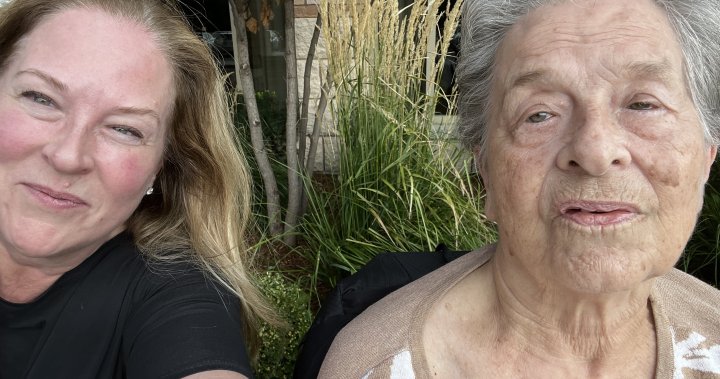With menopause becoming more mainstream this year, advocates in Canada are hopeful this shift could drive progress in health care and workplaces to better support women in what can be a very difficult stage in their life.
In an aging population, more women in their 40s and 50s are openly talking about their own experience with menopause on social media and elsewhere.
“Menopause is definitely having a moment, but I think it’s actually turning into a movement,” said Janet Ko, president and co-founder of the Menopause Foundation of Canada (MFC).
“I believe it’s become more mainstream because gen-X women are driving the conversation and demanding a different experience than their mothers and grandmothers,” she told Global News in an interview.
Despite the push to raise awareness, women across the country continue to face stigma around menopause and there is a lack of support at workplaces, experts say.
And that comes with a financial burden.
A report by the Menopause Foundation of Canada in October found that unmanaged symptoms of menopause cost the Canadian economy an estimated $3.5 billion each year.
The report said employers take a financial hit of $237 million annually in lost productivity, and women lose $3.3 billion in income because of reduced hours, diminished pay, or leaving the workforce altogether.
In Canada, there are more than 10 million women over the age of 40, so roughly a quarter of the population have either hit menopause or are in perimenopause.
Get the latest Health IQ news.
Sent to your email, every week.
Most women hit menopause — marked by not having had a menstrual period for one year — between the ages of 45 and 55.
Perimenopause is the transition period, lasting six to eight years, leading up to menopause when a women’s menstrual cycles could become irregular as the hormone levels fluctuate.
These are the “prime earning” years of working women who can get hampered by the physical and mental health challenges associated with menopause, said Helena Pagano, chief people and culture officer at Sun Life.
Some of the common symptoms of menopause include irregular periods, hot flashes, night sweats, headaches, mood swings and joint pain.
Women in menopause may also lack energy, have trouble sleeping, experience depression and bladder control issues.
“It’s impacting them at work right at a time that women should be … optimizing their career, optimizing their earning potential, being their best, delivering their most at the pinnacle of their career,” Pagano said in an interview with Global News.
Sun Life, in partnership with the MFC, has been advocating for a more inclusive workplace for menopausal employees.
As part of that effort, they have created a playbook for employers that was launched in October and that highlights a five-step plan to offer menopause support at work.
To reduce stigma, the playbook encourages open dialogue about menopause with informal round tables and including men in those conversations.
Creating specific menopause policies or incorporating menopause in existing policies is also part of that action plan.
Where needed, employees should be accommodated with flexible working hours, remote work, and shift timing changes, the guidelines state.
To make employees more comfortable, there should be improved ventilation, washrooms with large enough garbage containers and easy access to cold drinking water. If a uniform is required, the focus should be on breathable natural fibres with options for layering.
Employers should also ensure adequate mental health coverage to support workers in menopause. They are also encouraged to press their virtual care providers to expand expertise related to menopause.
Ko said she would like to see workplaces in Canada adopt these changes that could make a “big difference” for a “critical cohort of working women” in the country.
“We need workplaces to break the stigma, close the knowledge gap and to download our playbook and take action to ensure that they’ve created a menopause inclusive workplace for women in the prime of their lives,” she said.
Pagano said there is an increasing appetite for open and safe conversations around the topic in the workplace.
She is hopeful more Canadian employers get on board and help close the gender health gap in the country.
In Canada, there are several treatment options available for menopause symptoms, including hormone therapy, over-the-counter medications and prescription drugs.
Hormone therapy (HT), which can be administered by pills or transdermally via a patch or a gel, is approved by Health Canada and given by prescription.
Experts say it is more effective than non-hormonal options to treat menopause symptoms.
If there are no contraindications to starting menopausal hormone therapy, it should be the first-line treatment for vasomotor symptoms, like hot flashes and night sweats, according to a paper published in the Canadian Medical Association Journal in May.
Dr. Michelle Jacobson, a menopause specialist at the Women’s College Hospital in Toronto, said it’s great to have a variety of drug options that have come to the Canadian market in recent years.
However, she said the country is still struggling with access to good non-hormonal options and very few menopause specialists, adding there continues to be fears around the use of hormonal medications — even though they have been proven to be safe and effective.
“Menopausal hormone therapy can be safely initiated in women without contraindications who are younger than 60 years of age or less than 10 years post-menopause,” according to guidelines from the Society of Obstetricians and Gynaecologists of Canada.
Ko said more health-care practitioners need to be up to speed on the clinical practice guidelines used to treat menopause and get more comfortable having those conversations with patients.
A report last year by the Menopause Foundation of Canada found that of the 41 per cent of women surveyed between the age of 40 and 60 who sought medical advice, 72 per cent found that was not helpful or only somewhat helpful. Nearly 40 per cent of women also felt their symptoms were undertreated, the report said.
“Sadly, our health-care practitioners receive almost no education on menopause, so they’re very ill prepared to support women,” Ko said.
She also said provinces should cover all forms of menopause hormone therapy and should be supportive of other new non-hormonal treatment options that are on the horizon.
Given the momentum over the past year and the increased pressure from women themselves, both Ko and Jacobson are optimistic about seeing progress in tackling menopause.
“I’m very confident that the next year is going to bring a significant improvement in the way we frame menopause, the way we treat menopause,” Jacobson said.




